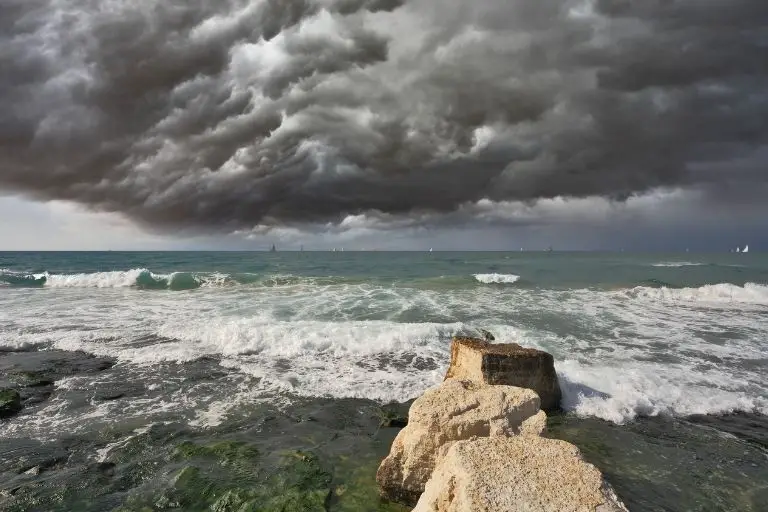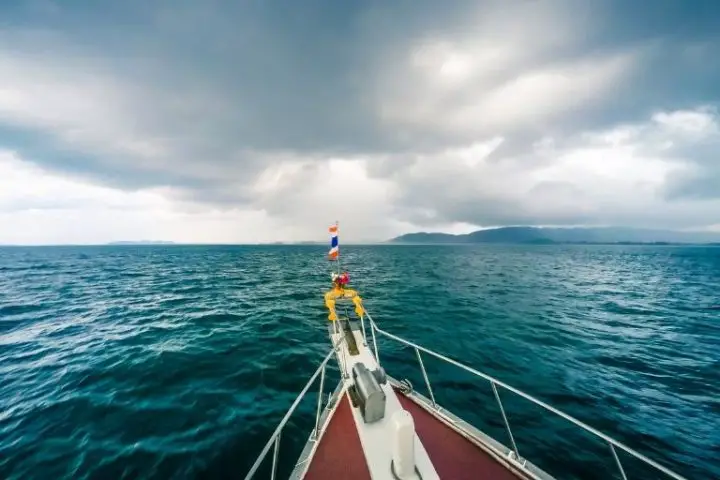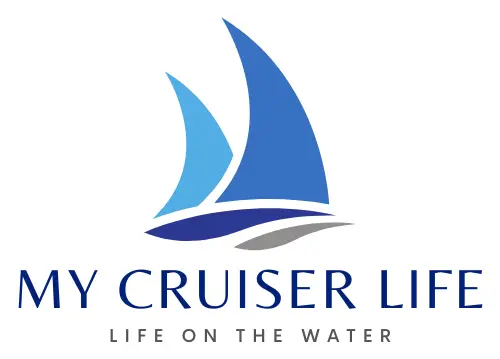There are few constants in boating—and the weather is certainly not one of them. It is constantly changing, ready to do the unexpected and surprise you at the last minute. Maybe it’s a good surprise, and you’re delighted with glassy-calm water and the beach all to yourself. Or maybe it’s an unpleasant surprise, full of roiling whitecaps, seasick passengers, and lightning.
If you get stuck caught in a storm, your should immediately head back to your home dock if possible. Otherwise, it is advised to anchor the boat in a nearby harbor or quiet cove. Everyone on board needs to be wearing their life jackets, and you should secure the boat in every way possible.
Stormy weather doesn’t need to be an unpleasant surprise, however, if you keep an eye on the conditions and listen to the weather forecast carefully, chances are you’ll spend years boating safely with no nasty surprises. Never mind whether science and a falling barometer—today, there are special marine warning services that will advise you well in advance of local hazards, strong winds, or rough water.

Severe Weather and Boating
There are two types of bad weather boaters need to think about. One is the type that you should know is coming your way. However you get your weather (more on that later), the weather gurus told you to stay home. Yes, it requires that you look at the weather and trust the gurus. Yes, sometimes the gurus get it wrong. But they get it really close more often than people like to think.
If you get up one morning to go boating, and the forecast says there’s a tropical storm watch and a 100 percent chance of high winds and thunderstorms, most people would choose not to go boating. If there’s a 60 percent chance of thunderstorms at 2:00 pm, many people would say that the morning sounds nice. A cautious boater might even get off the water by noon, just to be safe.
So that’s one type of bad weather—the type that you knew was coming. It was forecast to occur, and the prudent boater just stayed home that day.
The other type of weather catches you off guard. Perhaps you’re out on a hot and humid summer day, and the thunderstorms built up. They usually do on days like that, so you weren’t surprised. But this day, they built up earlier, stronger, or more widespread than usual. Whatever happened, you got stuck out there.
Thunderstorms represent one of the biggest threats to boaters. They have the power to move or develop quickly, and in some instances, they can move into the area far faster than your boat can drive away.
Regardless of the cause, hazardous weather on a boat can be roughly divided into four main problems.
- High winds
- High seas
- Lightning
- Low visibility
It should be noted that most boating accidents occur not due to bad weather alone—but because the operator made some really bad decisions along the way. Being safe on the water is all about understanding and weighing the risks involved.
Getting Weather Information on Your Boat
Figuring out what the weather is going to be like on your boating trip has never been easier. In addition to the traditional sources for boating weather, like the NOAA marine weather radio stations, there are now countless apps that can tell you on your phone.
But this plethora of information also makes it harder. Sometimes the apps provide conflicting information. Sometimes the data has been disseminated by a forecaster who knows how to interpret the raw data. Other times, the app just presents the raw data and expects you to interpret it. As a result, there’s a lot of confusion among boaters about which app is better, but there’s even more confusion about what the apps are actually telling you.
When in doubt, it’s always a good idea to have one trusted source. Then, apply the age-old saying—”trust but verify.” Take your trusted source, and then figure out why it says what it says and how confident they seem to be in saying it.
In the US, the best source is the NWS marine zone forecasts. These cover all near-shore waters in the United States, and they break down the weather with an easy-to-understand synopsis, winds and seas forecast, and outlook. You can get the product online from many websites and apps or hear it read on the radio by Iron Mike (an automated voice) on your marine VHF radio. The simple VHF radio is one of the most important pieces of electrical equipment on your boat.
Beyond this primary source, it isn’t easy to rate apps. Most show raw data from global weather models, all of which have various strengths and weaknesses. Without a lot of practice and local knowledge, it is challenging to produce a reliable forecast based solely on computer models. The folks at the National Weather Service have years of practice and local knowledge.
Getting Weather at Sea – National Weather Service and US Coast Guard Broadcasts
The easiest way to get the weather for your area is to switch your marine VHF radio to the weather band. Then scan through the channels to find the frequency with the strongest signal. You can find information on these frequencies and coverage on the NWS website.
Text marine weather forecasts can be accessed directly from their website, as well.
The US Coast Guard usually announces weather warnings on VHF Channel 16. Small craft advisories and hurricane warnings are usually called out, and these warnings are typically included in all weather apps and commercial news broadcasts.
What Should You Do If You’re Stuck in Severe Storm Conditions?
It happens to the best of boaters—sometimes you get stuck in some weather you’d rather not have gotten stuck in. What do you do? If the weather is deteriorating and you begin to think it might get a little hairy, you absolutely should start by ensuring that every person on board is wearing a life jacket. Go to extra measures to keep everyone safe and ensure there is no risk of anyone falling overboard.
What is the best course of action if you see a thunderstorm approaching on a boat? First, it pays to keep a sharp lookout for any impending storms. If you notice dark clouds or vertically rising clouds with enough notice, you may be able to avoid getting stuck in an approaching thunderstorm. Keep an eye out for these warning signs, and you can likely go your entire life without getting “stuck” in bad weather.

Option 1 — Dock the Boat
If time allows, the best outcome would be to return to your home dock. If home won’t do, is there another dock where you can tie up to wait out the weather? Being off the water, safe and sound (and dry) in a building is the best option. If it means an unscheduled layover and the marina across the lake or an impromptu lunch at the dock-and-dine while the weather passes, take that option.
But let’s say it’s moving fast, blocking your access to safe harbor, and you’re running out of options. The rest of the choices will be based on your geographic area and what options present themselves.
Option 2 — Anchor in a Protected Anchorage
If no dock is available, is there a snug harbor where you can drop the anchor and wait out the storm on the hook? Ideally, you want to do this in a quiet cove where the land blocks the prevailing wind of the storm. Of course, it’s best to have the locations of such places picked out in advance, but if it comes to it, don’t hesitate to pull out your marine charts and have a look.
At all costs, avoid the “lee shore.” A lee shore has the wind blowing onto land. If you anchor here, and your anchor drags, you’ll wind up on the beach or the rocks. Of course, this is the worst-case scenario, but it proves that the lee shore is the last place you want to find yourself in a blow.
The best anchorages provide a wind block. That means that the boat isn’t exposed to the worst of the weather, and the limited space prevents waves from building up. The closer you can get to shore (draft allowing), the better the conditions will be.
Option 3 — Storms Underway
If neither of these options presents itself, you’ll have to continue on your way. Everyone on board needs to be wearing their life jackets, and you should secure the boat in every way possible. Tie-down loose objects and close all lockers and companionway doors. Turn on your navigation lights, and be ready for maneuvering in low visibility conditions.
Only you know the design of your boat and what it is possible of taking. Most boats are far harder than the boaters that drive them. This is especially true of open water power and sailboats.
Winds
In the case of a sudden thunderstorm, the leading edge of the storm will contain the most potent and damaging winds. This gust front comes with little warning, and it may or may not accompany the downpour of rain right as the storm hits. So besides securing loose canvas and items topside, there’s not much a typical power boater can do.
Sailboats, of course, are made for catching the wind. But thunderstorms, especially sudden ones, can pack surprising punches. Wind gusts over 50 knots are not uncommon. Sailors are best advised to reef early and reduce canvas to prep for the worst-case scenario. It is much easier to do it in advance than doing it when it’s too late.
Failure to reduce sail before an approaching gust front can cause damage to the rigging or sails. It could also result in the boat being knocked down—healed over so far by the wind pressure that the sails end up in the water. Well-founded offshore vessels will recover quickly, but damage to the rigging is all but assured.
Wind direction will play an important role in your decision-making process.
Rough Seas
Large waves and rough seas are a real danger to some vessels, but a lot depends on the wave conditions and the size and design of your vessel. Most boats take heavy weather best at a 45-degree angle headed into the wind speed. However, some may find 45 degrees off of dead downwind a more comfortable ride.
Heading directly into heavy swells may cause you to bury the boat’s bow into the next swell. This can cause a dangerous situation known as pitch-poling. A pitch-poled vessel buries its bow into a wave and tumbles end over end.
Taking heavy swells on the side or beam of the boat can be just as dangerous. Boats may roll too far and capsize.
The good news is that sudden thunderstorms seldom have time to build up hazardous sea conditions. Of course, it might get rough, but unless combined with an existing offshore swell (the kind that is well-forecast), the seas will usually not be catastrophic.

Lightning
Lightning strikes might be the scariest hazard on the water, and it’s one that you can do little to protect yourself against. Lightning usually strikes the highest object, and when out on the water, that is almost always a boat. So stay low in the boat, and don’t make yourself the highest object. If your boat has an inside helm, steer from there.
Lightning can cause catastrophic damage to the vessel and electrical equipment, and it can be fatal. Theoretically, the vessel’s structure should protect the occupants—as long as they aren’t in contact with any metal objects like the rigging or railings.
Prepping Your Boat for Big Storm at the Dock
There’s an old sailor’s saying that goes something like, “It’s better to be safe in harbor wishing you were at sea than to be at sea wishing you were in a safe harbor.” The best part of being docked is that you can be warm and safe in your home while your boat takes on the elements.
Prepping your boat for a hurricane warning or other severe weather is no joke, though. Even small boats can take the better part of an entire day to get ready.
There are many articles out there on how to properly prep a boat for storm conditions. Here’s just a taste of the things you’ll want to do. Needless to say, you should have a storm plan ready to be enacted anytime your boat is in the water. It’s so much easier just to follow the plan than to make it up as you go along.
- Analyze your dock’s location and make sure it is well-protected from the wind and wave direction. If it’s not appropriate and you need to move the boat or have it hauled out, you’ll need to make and enact those plans well in advance—probably before any storm warnings go into effect.
- Double or triple all of your dock lines. Every line needs to have chafe protection.
- Check all bilge pumps and ensure your batteries are topped up. The bilge pumps will be the only thing keeping the bilges free of water. The shore power is likely to be disconnected during a storm. Turn off all other electrical equipment.
- Remove all sails and canvas from the boat. Do everything you can to reduce windage.
- Take a look at your dock neighbors and make sure that they’ve taken similar measures. Time spent helping other boaters nearby is time spent protecting your boat.
Conclusion
Boaters shouldn’t be frightened of the weather, but they should practice their ability to interpret weather forecasts every day. A good skipper knows how to manage risk—so what weather is too risky for you and your crew? On that same note, never underestimate the value of your crew’s comfort as well. It might be safe to be out, but is the crew happy and comfortable?
The first step to beating nasty weather at sea is to avoid being out in it. Exercise sound judgment and keep abreast of the latest weather forecasts along your route. Always.
